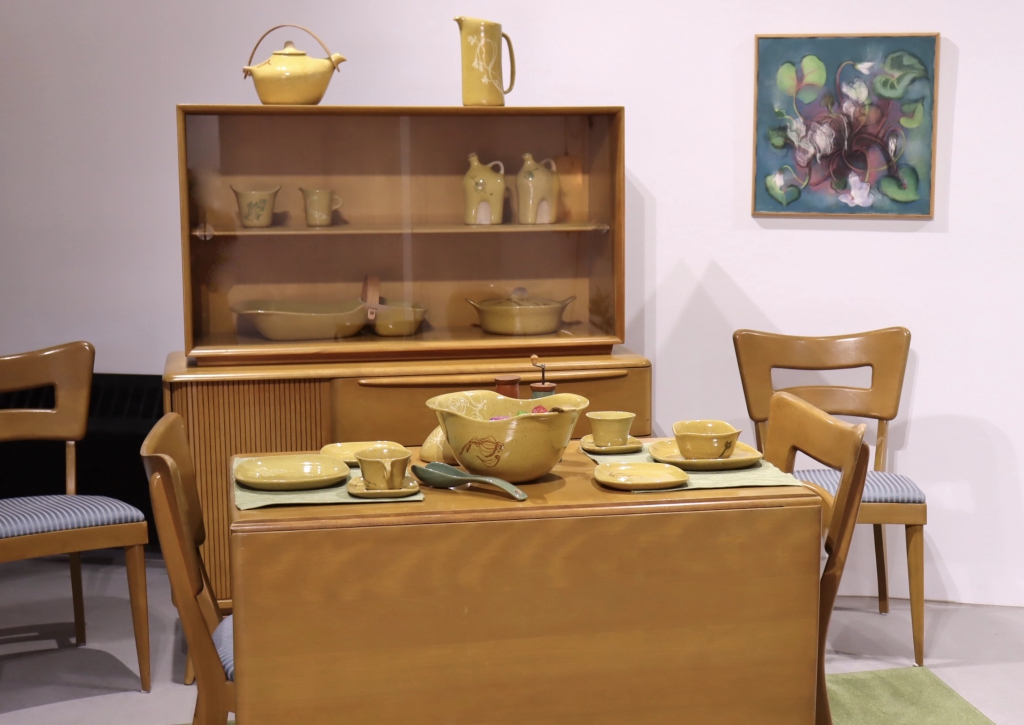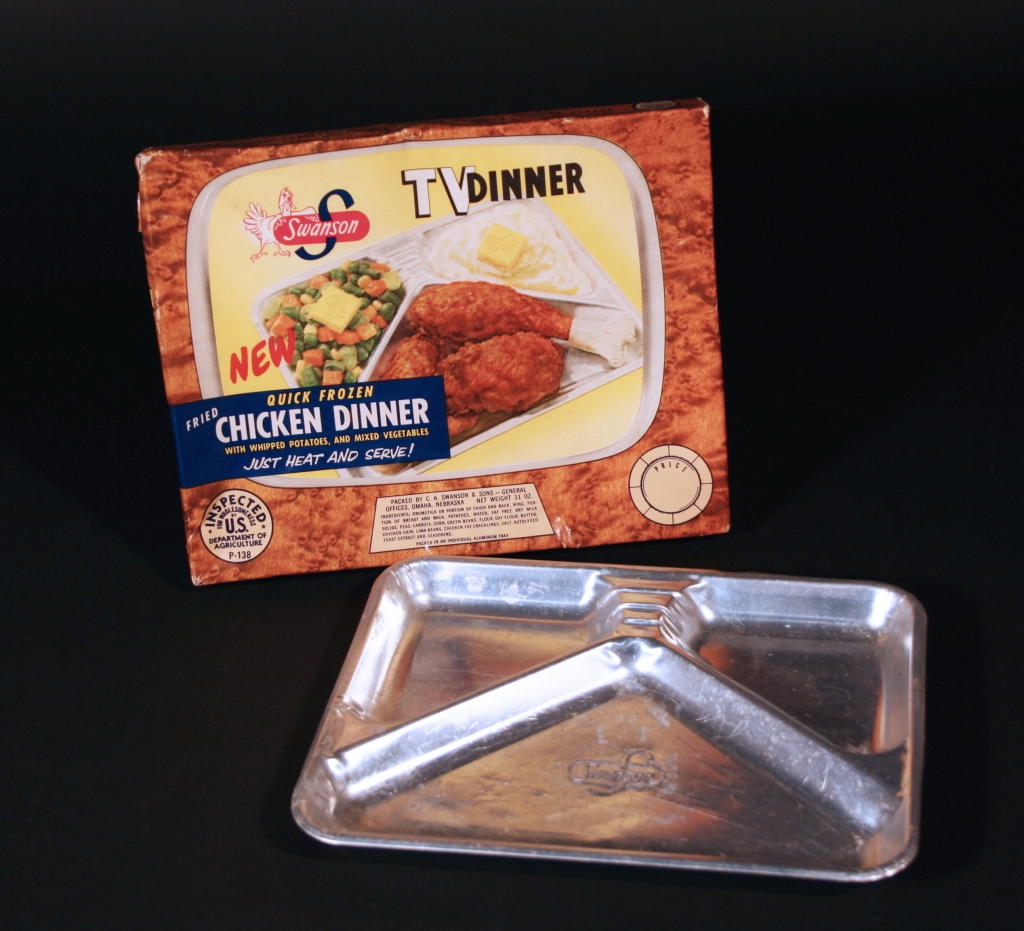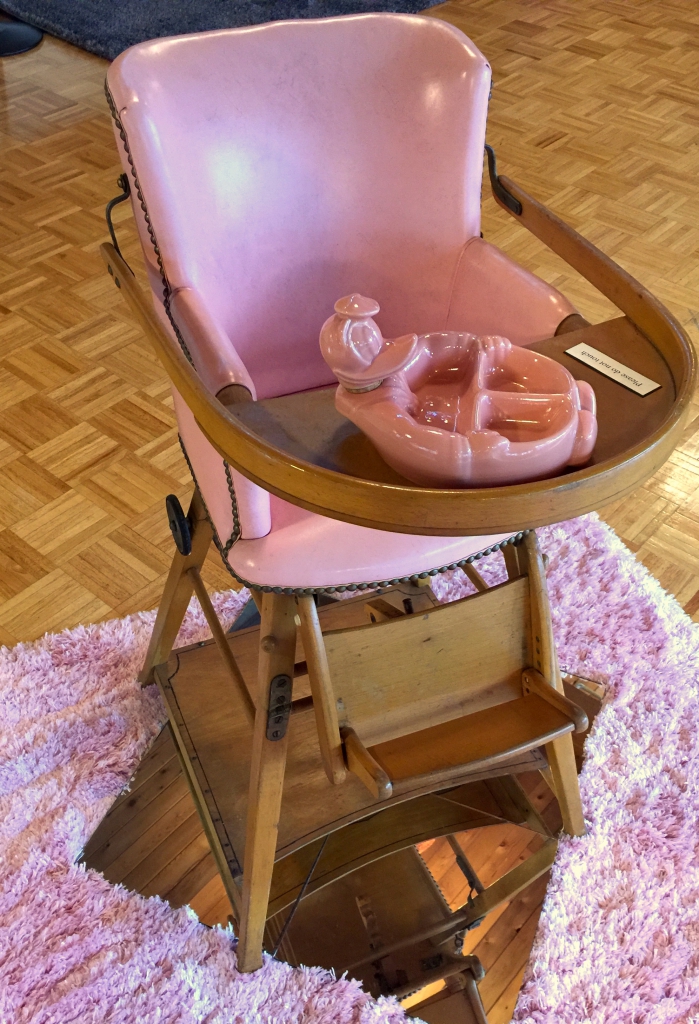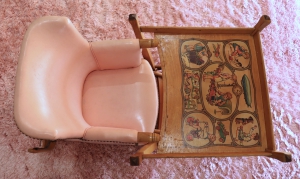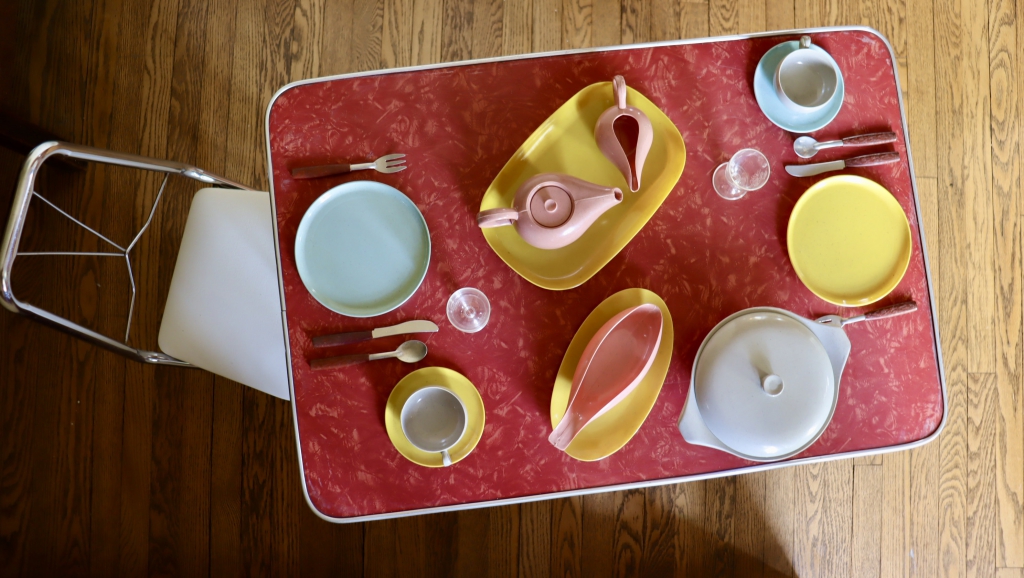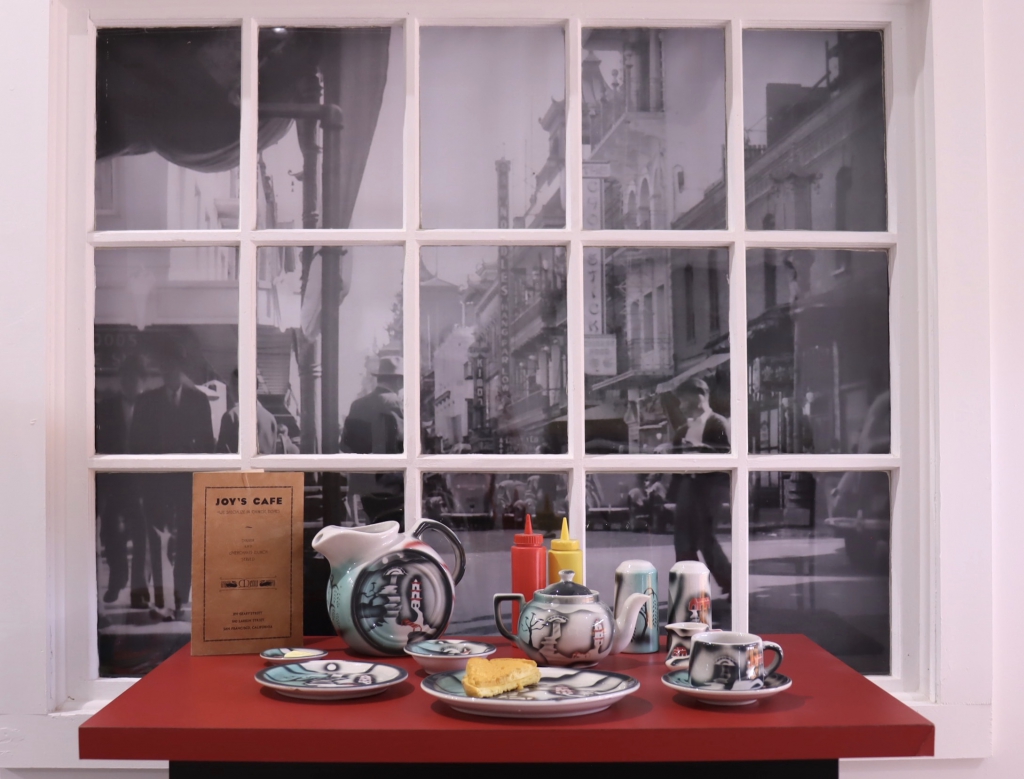Dining Memories
Dining Memories
Dining Memories, one of IMoDD’s two inaugural exhibitions in our first brick and mortar facility in Kingston, New York is full to the brim with nostalgia. Dining memories are frequently shared experiences between siblings, gatherings of friends and relatives for weddings and special holidays; dining out (movie theatres, restaurants, picnics, bars, travel adventures). On occasion there is a longing to return to a memorable restaurant, now shuttered.
While many dining memories may be quite personal, they are often shared by many in general terms (picnics, recalling early TV dinners, vintage diners).
Glidden Pottery Alfred Stoneware/Buffetware in Saffron, Cayenne, and Parsley
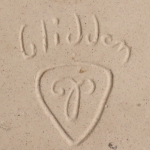 Glidden Pottery is a unique stoneware bodied dinnerware and Artware that was produced in Alfred, New York from 1940 to 1957. Glidden Pottery utilized modern production methods of slipcasting and ram pressing, but each of the more than 300 shapes was individually glazed and hand-decorated. Most pieces were marked with a Glidden Pottery signature or backstamp that varied over the years.
Glidden Pottery is a unique stoneware bodied dinnerware and Artware that was produced in Alfred, New York from 1940 to 1957. Glidden Pottery utilized modern production methods of slipcasting and ram pressing, but each of the more than 300 shapes was individually glazed and hand-decorated. Most pieces were marked with a Glidden Pottery signature or backstamp that varied over the years.
There was a market in the United States, especially after World War II, for everyday, affordable, yet chic goods such as Glidden Pottery. With a 16-piece undecorated starter set selling for $14.50, acquisition of Gliddenware was a reality for many.
 The founder of Glidden Pottery, Glidden Parker, had been a special graduate student at the New York State College of Ceramics during both the academic year and the summers from 1937 to 1939. His professors included Miss Marion Fosdick and noted industrial designer Don Schreckengost. The painting in this vignette is by Glidden Parker’s teacher Catherine Nelson, known to everyone as “Miss Nelson.”
The founder of Glidden Pottery, Glidden Parker, had been a special graduate student at the New York State College of Ceramics during both the academic year and the summers from 1937 to 1939. His professors included Miss Marion Fosdick and noted industrial designer Don Schreckengost. The painting in this vignette is by Glidden Parker’s teacher Catherine Nelson, known to everyone as “Miss Nelson.”
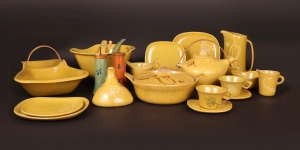 While there were a number of outstanding designers at Glidden Pottery in addition to Glidden Parker, most notable may be Fong Chow and Sergio Dello Strologo. Dello Strologo designed the Alfred Stoneware/Buffetware in Saffron, Cayenne, and Parsley that was introduced in 1956. The decorations on the pieces are the inspiration of Fong Chow. An original advertisement noted, “Glidden Stoneware, the first casual dinnerware and serving accessory group of stoneware on the American market, is produced in limited quantities for those who demand the ultimate in handsome, informal service. Crafted with consummate care, the ware retains the inherent warmth and character of the natural material. It proves that good craftsmanship, in good taste, need not be expensive.”
While there were a number of outstanding designers at Glidden Pottery in addition to Glidden Parker, most notable may be Fong Chow and Sergio Dello Strologo. Dello Strologo designed the Alfred Stoneware/Buffetware in Saffron, Cayenne, and Parsley that was introduced in 1956. The decorations on the pieces are the inspiration of Fong Chow. An original advertisement noted, “Glidden Stoneware, the first casual dinnerware and serving accessory group of stoneware on the American market, is produced in limited quantities for those who demand the ultimate in handsome, informal service. Crafted with consummate care, the ware retains the inherent warmth and character of the natural material. It proves that good craftsmanship, in good taste, need not be expensive.”
The Glidden Pottery is a perfectly matched with the Heywood Wakefield furniture of the era.
Peter Max and the Far Out Hippie Scene
Peter Max was born in Germany in 1936. He came to the United States with his family in 1953 and studied at the Art Student’s League, the Pratt Graphics Art Center and the School of Visual Arts in New York City.
 In 1967, the Iroquois China Company introduced the pattern, Love, which was designed by Peter Max. Love was described as a “psychedelic style splashed across” Iroquois China plates, mugs and bowls. The pattern was part of the Iroquois China Cliff-Dwellers line in the colors blue, red, yellow, and green.
In 1967, the Iroquois China Company introduced the pattern, Love, which was designed by Peter Max. Love was described as a “psychedelic style splashed across” Iroquois China plates, mugs and bowls. The pattern was part of the Iroquois China Cliff-Dwellers line in the colors blue, red, yellow, and green.
 The Butterfly decoration was offered in a 1968 China, Glass and Tableware trade magazine as yet another pattern in the Iroquois Cliff-Dwellers line. Butterfly was described as an “art nouveau design” in pink, blue, and orange against a taffy brown background. Back in the day a gift-packed set for two retailed for $14.95, as did the Lovepatterned set for two. [excerpted from Jo Cunningham’s The Best of Collectible Dinnerware book, revised 2nd Edition, 1999]
The Butterfly decoration was offered in a 1968 China, Glass and Tableware trade magazine as yet another pattern in the Iroquois Cliff-Dwellers line. Butterfly was described as an “art nouveau design” in pink, blue, and orange against a taffy brown background. Back in the day a gift-packed set for two retailed for $14.95, as did the Lovepatterned set for two. [excerpted from Jo Cunningham’s The Best of Collectible Dinnerware book, revised 2nd Edition, 1999]
The Peter Max dishes were donated by Linda Arbuckle. The 10” Love ashtray was an IMoDD purchase.
The orange mushroom stool dates from 1969-1970, as do the original Softstik Shagees carpet squares, the peace symbol necklace, tie dyed sash, and Bob Dylan poster and record album. The gently used and folded Bob Dylan poster, designed by Milton Glaser in 1966, was probably originally tacked to someone’s dorm room wall. The faux marijuana plant is of unknown origin. It just magically appeared.
TV Dinner Dining
 This 1958 Philco Predicta television appeared in someone’s living room several years after airlines first began serving frozen dinners to their passengers. The invention of the TV dinner, served in homes in front of TV sets beginning in the 1950s, has been claimed by several Swanson relatives and employees. Apparently there is no doubt that the cleveradvertising name of “TV Dinner” originated with the Swanson brand. Of course each meal was pre-packaged and frozen in an aluminum tray and placed in an attractive box featuring the individual servings of tasty-looking turkey, potatoes, vegetables, and sometimes soup or dessert. They were heated in the oven at home.
This 1958 Philco Predicta television appeared in someone’s living room several years after airlines first began serving frozen dinners to their passengers. The invention of the TV dinner, served in homes in front of TV sets beginning in the 1950s, has been claimed by several Swanson relatives and employees. Apparently there is no doubt that the cleveradvertising name of “TV Dinner” originated with the Swanson brand. Of course each meal was pre-packaged and frozen in an aluminum tray and placed in an attractive box featuring the individual servings of tasty-looking turkey, potatoes, vegetables, and sometimes soup or dessert. They were heated in the oven at home.
The beauty of the TV Dinner was that one could consume it directly from the aluminum tray. The box and aluminum were deemed disposable and there was no advanced meal planning, no leftovers, and there were no dishes to wash. Basically, they were fun.
Swanson added desserts such as brownies or cobblers to their TV Dinners in 1960, and they offered “Hungry-Man Dinners” in 1973. Microwave safe trays were introduced in 1986. Swanson wasn’t alone in marketing TV Dinners. The other major brand was Banquet.
Even “Lassie” re-runs seem to be a thing of the past, but it was a television staple in 1960 when this TV Guide was published.
High Chair Fine Dining
High chairs have been used for feeding older babies and young toddlers for centuries. Such specialized chairs make it easier to feed and tend to the infant’s needs. The Metropolitan Museum of Art has a high chair in its permanent collection that dates to around 1700 and is constructed of maple and hickory. It was donated to the museum in 1909. 18th and 19th century examples can be found in quite a few museum collections.
What is most interesting about each high chair, is that just like adult-size furniture, children’s pieces follow the fashions and trends of the era in which they were made. There are 18th century high chairs in the old-fashioned Windsor style with nicely turned legs, rails, and stretchers, and a shaped seat. There were no trays on high chairs until around the 1950s. But from early times there is usually a foot rest and some kind of strap to help hold the child in the chair.
Another style sometimes referred to as a Victorian high chair in the 19th and 20th century, frequently is “convertible”. Some could be converted to chair-and-table combinations, and others into rocking chairs, or wheeled walkers. Styles of chairs might be referred to as of the Eastlake-style or something similar.
The original owner of this deluxe pink upholstered high chair is unknown. It was purchased by IMoDD in Livonia, Michigan. It probably dates from the 1950s. It is a convertible model, that becomes a wheeled walker. It has delightful colorful decorations which remain hidden until the high chair has been converted to a wheeled walker. See the mirror for more details.
 The focus of this vignette is actually the Hankscraft baby food warmer from the 1940s or 1950s. This baby-girl pink ceramic feeder, in the shape of Donald Duck floating on his back, was meant to be filled with hot water to keep the baby’s food warm in the era before microwaves. Marshall W. Hanks founded Hankscraft in Reedsburg, Wisconsin in the 1940s. He received the patents on his products and then contracted this one out to Redwing. Hankscraft also made ceramic humidifiers and bottle warmers in addition to clowns and Humpty Dumpty-shaped baby food warmers.
The focus of this vignette is actually the Hankscraft baby food warmer from the 1940s or 1950s. This baby-girl pink ceramic feeder, in the shape of Donald Duck floating on his back, was meant to be filled with hot water to keep the baby’s food warm in the era before microwaves. Marshall W. Hanks founded Hankscraft in Reedsburg, Wisconsin in the 1940s. He received the patents on his products and then contracted this one out to Redwing. Hankscraft also made ceramic humidifiers and bottle warmers in addition to clowns and Humpty Dumpty-shaped baby food warmers.
Leftovers in 1948 Fridgidaire with 1930s refrigerator ware
Dining is never truly finished until the midnight craving for just a bite of this and bite of that occurs and the fridge in the kitchen is raided for leftovers. This 1948 Fridgidaire was made by General Motors and vintage advertisements show how it looked crammed full of food and beer.
Don’t you think it looks better with leftovers in dreamy blue refrigerator ware made by Hall China “exclusively for Westinghouse”? The “best” are Art Deco streamlined from the 1930s such as the water pitcher, ca. 1938. The color has been described as delphinium blue or periwinkle blue. Or even Westinghouse blue.
There were three basic categories of Hall refrigerator ware, including covered water containers or servers, boxes for leftovers, and covered butter dishes.
The three Hotco Art Deco two-tone blue and white graduated sizes of refrigerator ware pitchers on the enamel kitchen table were donated by the family of Viktor Schreckengost. They were designed by Viktor and owned by him. They were manufactured by the Salem China Company in 1937. They are unmarked.
The remainder of the refrigerator ware was donated by Vicki Matranga or purchased by IMoDD.
The RMS Queen Mary and the Cubed Tea Service
 Our Cunard White Star Line Queen Mary vignette features an English Foley China tea service that may or may not have ever been used on the Queen Mary, along with an original folio 1936 Queen Mary brochure and a Cunard 1937 embossed breakfast menu. This deck chair was definitely never on the Queen Mary.
Our Cunard White Star Line Queen Mary vignette features an English Foley China tea service that may or may not have ever been used on the Queen Mary, along with an original folio 1936 Queen Mary brochure and a Cunard 1937 embossed breakfast menu. This deck chair was definitely never on the Queen Mary.

 This rare bone china tea service, manufactured in England by Foley China, was part of the experience of dining on the RMS Queen Mary, part of the Cunard Line, which sailed primarily on the North Atlantic Ocean from 1936 to 1967. The set consisted of a small teapot with a lid, demitasse cups and saucers, creamer, and sugar. It is said that the Queen Mary and her sister ship, the Queen Elizabeth, dominated the transatlantic passenger transportation market until the dawn of the jet age in the late 1950s. The Queen Mary was retired in 1967 and is now permanently moored at the port of Long Beach, California.
This rare bone china tea service, manufactured in England by Foley China, was part of the experience of dining on the RMS Queen Mary, part of the Cunard Line, which sailed primarily on the North Atlantic Ocean from 1936 to 1967. The set consisted of a small teapot with a lid, demitasse cups and saucers, creamer, and sugar. It is said that the Queen Mary and her sister ship, the Queen Elizabeth, dominated the transatlantic passenger transportation market until the dawn of the jet age in the late 1950s. The Queen Mary was retired in 1967 and is now permanently moored at the port of Long Beach, California.
Robert Crawford Johnson designed this cube teapot and registered the design in 1917. The teapot was dripless and poured easily. The cube shapes were chosen for use on the ships because of economies in stowage and reduction in breakages according to the written records of the day. The cubed shape eliminated fragile spouts and handles. A number of English companies supplied the roughly 30,000 pieces that comprised the china table service on board.
This cubed tea service was an IMoDD purchase, 2014.159.
[partially excerpted from en.wikipedia.org/wiki/RMS_Queen_Mary]
Children’s Playtime Dining
 This child-size dining vignette provides one snapshot in the evolution of children’s play dining. It can be assumed that toys dishes have been played with by children as long as there have been sea shells, leaves, and other vessels used for the consumption of food and beverages.
This child-size dining vignette provides one snapshot in the evolution of children’s play dining. It can be assumed that toys dishes have been played with by children as long as there have been sea shells, leaves, and other vessels used for the consumption of food and beverages.
 The Russel Wright (American, 1904-1976) children’s toy plastic American Modern dinnerware set was created in the mid-1950s by the noted designer, for his daughter Annie. It was manufactured by the Ideal Toy Company, in Brooklyn, New York (est. 1903). Our 58-piece set consists of plastic dishes, stemware, and flatware, all modeled on the adult-sized ceramic American Modern dinnerware that was extremely popular and manufactured between 1939-1959 by Steubenville Pottery. The sets were apparently sold through Sears, and a small tea for two set initially sold for 79 cents! What child didn’t want to own a set “Just like Mommy’s”? Some sources note that the stemware and flatware may not have been designed by Russel Wright. This set was one of the first acquisitions purchased for IMoDD after the museum was established in 2012, and is catalogued as IMoDD 2012.36. A set issued later, with different colors including orange and yellow, is also part of the IMoDD permanent collection.
The Russel Wright (American, 1904-1976) children’s toy plastic American Modern dinnerware set was created in the mid-1950s by the noted designer, for his daughter Annie. It was manufactured by the Ideal Toy Company, in Brooklyn, New York (est. 1903). Our 58-piece set consists of plastic dishes, stemware, and flatware, all modeled on the adult-sized ceramic American Modern dinnerware that was extremely popular and manufactured between 1939-1959 by Steubenville Pottery. The sets were apparently sold through Sears, and a small tea for two set initially sold for 79 cents! What child didn’t want to own a set “Just like Mommy’s”? Some sources note that the stemware and flatware may not have been designed by Russel Wright. This set was one of the first acquisitions purchased for IMoDD after the museum was established in 2012, and is catalogued as IMoDD 2012.36. A set issued later, with different colors including orange and yellow, is also part of the IMoDD permanent collection.
For more information about these dishes and other toy dishes, see our on-line exhibition Playful Dining, and the fascinating essay by Scott Vermillion.
Mid-Century Ritts of Los Angeles Tropitan line rattan bamboo bar cart paired with Ernest Sohn Creations barware, circa 1955
One furniture company, Ritts of Los Angeles, captured the allure of rattan during the mid-twentieth century. The company’s furniture designer was Herb Ritts. His wife Shirley was in charge of sales and marketing. The company produced popular patio furniture including dining tables and chairs, lounge chairs and end tables, and, of course, bar carts such as this. The Tropitan line of rattan bamboo furniture proved very popular in its time and is now highly collectible.
 A wonderful accompaniment to the rattan bamboo bar cart is the barware set created by Ernest Sohn Creations with a Corning Brand Heat Proof Glass beaker and four tumblers created using Federal Glass blanks, all hand-wrapped. They are in total harmony with the natural bamboo and wood of the bar cart. Note the bamboo stirrer included with the beverage server. The set is an IMoDD purchase 2020.172.
A wonderful accompaniment to the rattan bamboo bar cart is the barware set created by Ernest Sohn Creations with a Corning Brand Heat Proof Glass beaker and four tumblers created using Federal Glass blanks, all hand-wrapped. They are in total harmony with the natural bamboo and wood of the bar cart. Note the bamboo stirrer included with the beverage server. The set is an IMoDD purchase 2020.172.
Ernest Sohn was a giftware designer who designed for Red Wing and Glidden Pottery. In 1951, he started a showroom in New York City. He established Ernest Sohn Creations in the mid-1950s, which the approximate date of this barware set. Advertisements with similar Pyrex hand-wrapped beverage servers can be seen in the Gift and Art Buyer, the February 1952 issue. For more information see Earl James Martin’s 2007 Master’s Thesis A Useful and Decorative Home Accessory: Ernest Sohn Creations.
Well of the Sea restaurant, Chicago (1948-1972)

 The Well of the Sea was an acclaimed seafood restaurant located in the lower level of the Hotel Sherman in Chicago’s downtown loop at 112 W. Randolph at the northwest corner of Randolph and Clark Streets. The restaurant opened in 1948 and closed its doors around 1972. It was no ordinary restaurant. The interior was designed by artists, architects and interior designers to evoke the experience of dining under the sea. This was accomplished through the use of abstract murals and sculpture of fish, lures, and bait by Richard Koppe – all lit dramatically with black light.
The Well of the Sea was an acclaimed seafood restaurant located in the lower level of the Hotel Sherman in Chicago’s downtown loop at 112 W. Randolph at the northwest corner of Randolph and Clark Streets. The restaurant opened in 1948 and closed its doors around 1972. It was no ordinary restaurant. The interior was designed by artists, architects and interior designers to evoke the experience of dining under the sea. This was accomplished through the use of abstract murals and sculpture of fish, lures, and bait by Richard Koppe – all lit dramatically with black light.
Culinary historians may be captivated by the menu – bouillabaisse, rijstafel of seafood, café diable, and flaming rum punch; Mid-Century Modern art connoisseurs have fixated on the abstract undersea murals designed by Koppe; while dinnerware collectors cannot own too many place settings of the sturdy Shenango China restaurant quality dishes with the abstract fish motifs, designed by Shenango China’s noted designer Paul W. Cook.
 This vignette memorializes the magic of dining at the Well of the Sea during the 1950s-1960s, with original menus, dishes, flatware, mural reproduction and memorabilia from the restaurant. All of the dinnerware, menus and memorabilia are IMoDD purchases. All that is missing is the black lighting and oversized personalities of the day.
This vignette memorializes the magic of dining at the Well of the Sea during the 1950s-1960s, with original menus, dishes, flatware, mural reproduction and memorabilia from the restaurant. All of the dinnerware, menus and memorabilia are IMoDD purchases. All that is missing is the black lighting and oversized personalities of the day.
Watch our IMoDD announcements for an upcoming Zoom program all about the Well of the Sea phenomenon.
Picnic in the 1950-60s
The grass may not have been greener, but it is certain that the plastic dishes used on a picnic during the Mid-Century, were offered in a colorful, if not predictable palette indicative of the era – and sooooo popular. The larger 13” diameter plates packed for this picnic were manufactured by Plas-Tex Corp. of Los Angeles, California. The four colors included a soft grey, lime green, turquoise, and a salmon pink. There were divided plates that held your cup of Kool-aid, a sandwich, a chicken leg, dollop of potato salad, and the every-present jello fruit salad, with room left for a brownie or cookie.
 The beauty of the set isn’t just that it is unbreakable plastic. There were matching, tumblers, cups, utensils, and even napkins. It all fit in a neat metal picnic basket that everyone owned. There was a proliferation of cookbooks devoted to dining outdoors, which included picnics.
The beauty of the set isn’t just that it is unbreakable plastic. There were matching, tumblers, cups, utensils, and even napkins. It all fit in a neat metal picnic basket that everyone owned. There was a proliferation of cookbooks devoted to dining outdoors, which included picnics.
These picnic goers took along a Philco Transitone Portable Radio, Model 49-602, available 1948-49. This popular model came in a choice of ivory, maroon, brown and green plastic. At the time it cost around $29.95. According to an exhibition at the Henry Ford, titled 50 Years of High Design in Home Radio, “this radio marks several shifts in radio design and materials. This unit also echoes the rising trend of portability. Tube-driven radios like this would eventually yield to competition from the spread of transistor technology in the mid-1950s.”
Plaid picnic accessories were ubiquitous – coolers, thermoses, and more. A red and white checkered tablecloth was considered mandatory. Pie on a picnic was almost a guarantee.
The 1930s Diner and Tepco Restaurant Ware
Diners have been favorite gathering places for decades. It seems like good coffee and conversation go along with the diner counter and swivel stool environment. Part of the ambiance is the sturdy restaurant china which one encounters in the local diner.
 Among the many makers of restaurant china (Hall China, Homer Laughlin, Syracuse, Buffalo, etc.) is Tepco (Technical Porcelain and China Ware Company) which produced commercial or restaurant ware for 50 years. Tepco is a California brand, established in Richmond in 1918 and moved to El Cerrito in 1930. At its peak it employed 200 employees and produced 30,000 pieces a day. Tepco closed in 1968, though there are still restaurants out West that use their china.
Among the many makers of restaurant china (Hall China, Homer Laughlin, Syracuse, Buffalo, etc.) is Tepco (Technical Porcelain and China Ware Company) which produced commercial or restaurant ware for 50 years. Tepco is a California brand, established in Richmond in 1918 and moved to El Cerrito in 1930. At its peak it employed 200 employees and produced 30,000 pieces a day. Tepco closed in 1968, though there are still restaurants out West that use their china.
 Some sources say there are a million Tepco patterns. While it may only be hundreds or thousands, it is safe to say that if you think you’ve seen them all, you’ll certainly see a new one the next day. One of the largest commissions for dinnerware came from the U.S. Navy. Tepco made pieces for Trader Vic, including a Death’s Head mug for hot rum. Among the most captivating is a pattern known as Confucius, shown in this vignette, that some say was originally used in a restaurant in San Francisco. The rich color palette of greens, reds, charcoal and white are utilized in the stylized depiction of pagodas, bridges, streams, and trees.
Some sources say there are a million Tepco patterns. While it may only be hundreds or thousands, it is safe to say that if you think you’ve seen them all, you’ll certainly see a new one the next day. One of the largest commissions for dinnerware came from the U.S. Navy. Tepco made pieces for Trader Vic, including a Death’s Head mug for hot rum. Among the most captivating is a pattern known as Confucius, shown in this vignette, that some say was originally used in a restaurant in San Francisco. The rich color palette of greens, reds, charcoal and white are utilized in the stylized depiction of pagodas, bridges, streams, and trees.
Most of the Tepco China in the IMoDD collection, which numbers in the hundreds, was donated by Nancy and Steve Selvin. A few pieces of the Confucius pattern were purchased by IMoDD. The 1930s Joy’s Cafe diner menu “we specialize in Chinese dishes” located in San Francisco (2024.44) is an IMoDD purchase.
References: American Craft magazine, “Tepcoware,” by John Heaven, Vol. 42, No. 4, August-September 1982, pp. 16-19; and The TEPCO Story YouTube created by the El Cerrito Historical Society, August 2020.


